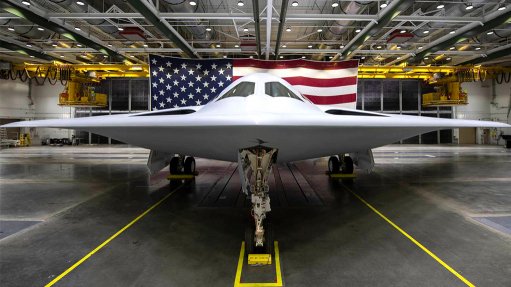
The B-21 Raider
Photo by: US Air Force
The US Air Force and major US aerospace and defence group Northrop Grumman jointly unveiled the world’s first sixth-generation jet combat aircraft, the B-21 Raider strategic bomber, late on Friday (South African time). The aircraft is considered sixth generation because, among other things, it employs stealth and ‘information advantage’ technologies with an open information technology architecture. Its information advantage comes from its advanced sensors, data collection and fusion capabilities.
The B-21 will be capable of networking to multiple systems, and in all domains (air, sea, land, space, cyber) across the ‘battlespace’. The aircraft has also been designed to be flown either with its crew on board, or remotely, with its crew on the ground.
“With the B-21, the US Air Force will be able to deter or defeat threats anywhere in the world,” affirmed Northrop Grumman VP and Northrop Grumman Aeronautics Systems president Tom Jones. “The B-21 exemplifies how Northrop Grumman is leading the industry in digital transformation and digital engineering, ultimately delivering more value to our customers.”
The media were allowed to view, and photograph, the new bomber only from the front. Consequently, its trailing edge, flight control systems and engine exhaust outlet arrangements all remain unknown. These are all of great importance regarding its stealth capabilities, both in the radar and infrared sections of the electromagnetic spectrum.
The B-21 is clearly a flying wing, like its predecessor, the B-2 Spirit, which is also a Northrop Grumman design. Northrop Grumman first pioneered flying wings in 1941, when the then Northrop developed the N-9M flight test aircraft, which first flew in 1942. This was followed by the XB-35/YB-35 experimental four-piston engine-powered flying wing bombers, succeeded by the eight-jet engine YB-49, of which two were built. But, in the pre-digital era, flight control proved difficult. (One of the YB-49s was lost in a fatal accident.) The YB-49 programme was cancelled in 1950. Taking advantage of the benefits of fly-by-wire flight control technology, Northrop revived the flying wing concept for the B-2, because, as had been noted with the YB-49, this type of design produced a small radar cross section.
The B-21 is the world’s first new fully stealth bomber to be developed in some 30 years, the previous one being the B-2. While only 21 B-2s were ever built, because of the end of the Cold War and their very high cost, the US Air Force plans to buy 100 B-21s. Although expensive (around $700-million per aircraft), the B-21 should be significantly cheaper than the B-2 (which cost $929-million per aircraft). Both numbers reportedly include the cost of spares, ancillary equipment, software and so on.
“The B-21 Raider is testament to America’s enduring advantages in ingenuity and innovation,” said US Defence Secretary Lloyd J Austin III. “This bomber was built on a foundation of strong, bipartisan support in Congress. And because of that support, we will soon fly this aircraft, test it and then move into production.”